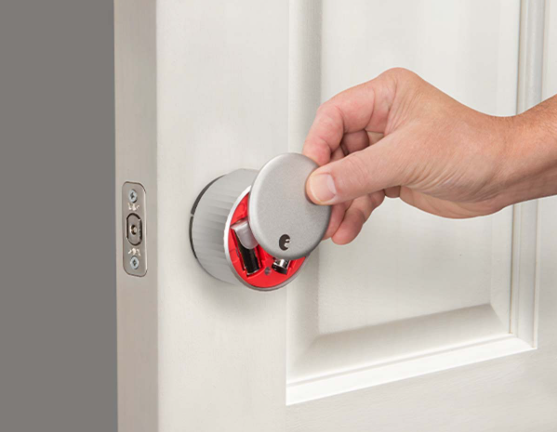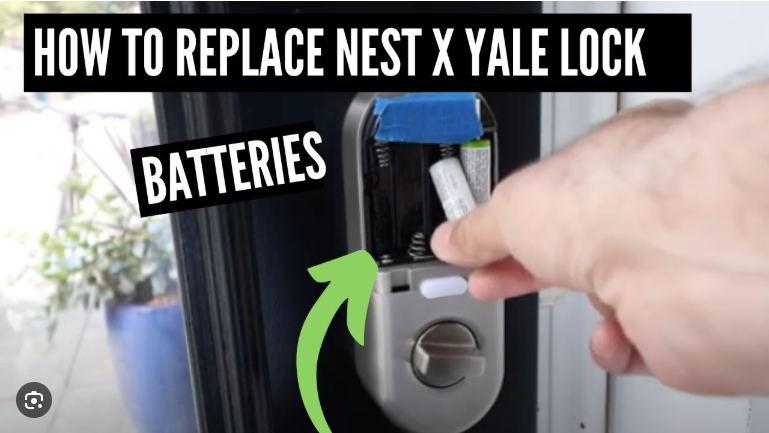Smart locks are transforming home security, but knowing how to replace smart lock batteries is essential to keep them running smoothly. A smart lock is an electronic lock that connects to your smartphone or smart home system via WiFi or Bluetooth, offering keyless entry, remote control, and features like fingerprint scanning or keypad codes. In 2025, smart locks are more reliable and user-friendly, making them a top choice for convenience and security.
Why focus on how to replace smart lock batteries? A dead battery can render your lock unusable, potentially locking you out. This beginner-friendly smart lock setup guide covers installation, app connection, and battery replacement, ensuring uninterrupted access. Tailored for wooden doors, we’ll walk you through every step of smart lock installation and provide tips for smart lock battery replacement. Whether you’re new to DIY smart lock installation or upgrading your smart home, this guide has you covered. Let’s get started!

What You Need Before Installing
Before diving into how to replace smart lock batteries, proper preparation ensures a smooth smart lock installation. Gathering tools and checking compatibility sets the stage for a successful DIY smart lock installation and hassle-free battery maintenance.
Tools Required: Most smart locks are designed for easy installation with common tools, including:
- Phillips screwdriver (sizes #1 and #2) for securing and removing screws.
- Flathead screwdriver for prying off old hardware.
- Tape measure to verify door dimensions and hole alignments.
- Drill with bits (if modifications are needed, though most smart locks fit standard deadbolt holes).
- Pencil for marking positions.
- Optional: A level for alignment and safety glasses for protection.
These tools, found in most home toolkits, make how to replace smart lock batteries and installation accessible. For install smart lock on wooden door, ensure tools are wood-friendly to prevent damage.
Compatibility Checks: Confirm your door’s suitability. Measure the door’s thickness (1-3/8 to 2 inches) and borehole sizes (2-1/8-inch face bore, 1-inch edge bore). For wooden doors, verify the wood is solid around the lock area. Check if the lock uses WiFi (2.4GHz, not 5GHz) or Bluetooth, and test signal strength for connect smart lock to WiFi. Ensure compatibility with smart home hubs like Alexa or HomeKit if desired.
Power Needs: Most smart locks run on four AA or AAA alkaline batteries, lasting 6-12 months. Some models use rechargeable batteries or wired power. Always keep spare batteries for smart lock battery replacement, as this is critical for how to replace smart lock batteries. For exterior doors, choose weatherproof models. Review the smart lock user guide for model-specific details, as brands like Yale, August, or Schlage provide app-based tutorials or QR codes for video guides. Preparation takes 15-20 minutes but ensures a smooth process.
Step-by-Step Installation Guide
This guide on how to replace smart lock batteries includes a complete smart lock installation process, tailored for wooden doors with standard deadbolts. We’ll also cover battery replacement steps to keep your lock operational.
Step 1: Removing the Old Lock
Start by replacing door lock with smart lock by removing the existing hardware.
- Open the door for easy access to both sides. Locate screws on the interior thumb turn or plate.
- Use a Phillips screwdriver to remove screws and detach the interior assembly.
- Slide the deadbolt mechanism out from the door’s edge.
- Remove the exterior cylinder or knob, unscrewing any fasteners. Insert the key if needed to release it.
- Unscrew the strike plate from the door frame.
This takes 5-10 minutes. If stuck, gently pry with a flathead screwdriver, avoiding damage to the wood for install smart lock on wooden door.
Step 2: Preparing the Door
Prepare the door for your new smart lock.
- Clean the deadbolt hole with a vacuum or cloth to remove debris.
- Verify borehole sizes (2-1/8-inch face, 1-inch edge). Adjust with a drill if needed, though most fit standard setups.
- Test-fit the new deadbolt, ensuring smooth extension and retraction.
This step, taking 5-10 minutes, is crucial for install smart lock on wooden door to prevent misalignment due to wood warping.
Step 3: Installing the Smart Lock
Mount the new smart lock hardware.
- Insert the deadbolt into the edge hole, aligning any “up” markings, and secure with screws.
- Attach the exterior assembly (keypad or scanner), feeding cables through the borehole.
- Secure the interior mounting plate, connecting cables to the interior unit.
- Attach the interior assembly over the plate and screw it in place.
- Install the strike plate on the door frame, aligning with the deadbolt.
Follow the smart lock user guide for model-specific adapters. This takes 20-30 minutes.
Step 4: Connecting with the App and Phone
Enable smart features with smart lock app connection.
- Download the manufacturer’s app (e.g., Yale Access, August Home) from your app store.
- Create an account and follow prompts to add a new device.
- Activate pairing mode (usually a button on the interior unit).
- For WiFi models, connect smart lock to WiFi using your 2.4GHz network. Bluetooth models pair directly.
- Calibrate lock/unlock functions and set features like auto-lock via the app.
Ensure your phone’s WiFi/Bluetooth is active and you’re near the door. This takes 10-15 minutes.
Step 5: Testing Functionality
Test to confirm the lock works correctly.
- Manually lock/unlock from both sides.
- Test keypad codes, fingerprint scanning, or app-based unlocking.
- Use the app for remote locking (WiFi models).
- Verify notifications by opening the door and checking your phone.
Testing, taking 5 minutes, ensures your smart lock installation is reliable.
Step 6: Replacing Batteries and Troubleshooting
Here’s how to address how to replace smart lock batteries and handle common issues with this smart lock troubleshooting guide.
- Battery Replacement: Check the smart lock user guide for the battery compartment location (usually on the interior unit). Remove the cover (often with a screwdriver or by sliding it off). Replace old AA/AAA batteries with fresh alkaline ones, ensuring correct polarity. Close the compartment and test the lock. Some models allow temporary power via a 9V battery to external terminals if batteries die unexpectedly. This takes 5 minutes.
- Connection Issues: If the app fails to connect, restart it, reset the lock, or check WiFi signal. Relocate your router for better connect smart lock to WiFi.
- Deadbolt Sticking: Realign the strike plate or lubricate the bolt with graphite spray.
- App Errors: Update firmware or reinstall the app.
- Unresponsive Lock: If the lock doesn’t respond, replace batteries immediately. If the issue persists, perform a factory reset (check user guide) and re-pair with the app.
For persistent issues, consult manufacturer support. Mastering how to replace smart lock batteries ensures uninterrupted access.

Tips for Successful Installation
With your how to replace smart lock batteries guide complete, these tips ensure a lasting DIY smart lock installation and reliable battery management.
Security Considerations: Choose a smart lock with strong encryption to prevent hacking. Enable two-factor authentication in the app and use complex keypad codes. Regularly update firmware to address vulnerabilities. For exterior wooden doors, select weather-resistant models to protect electronic components.
WiFi/Bluetooth Signal Placement: Ensure strong signals at the door. Wooden doors are ideal, as metal can interfere. Test connectivity across your home for reliable connect smart lock to WiFi. Use a WiFi extender or hub bridge if signals are weak.
Safety Precautions: Install with the door open to avoid lockouts. Store the backup key (included with most models) securely. Inform household members about lock operation. For smart lock battery replacement, set reminders every 6 months and use app alerts to monitor battery levels, preventing disruptions.
Additional Tips: Integrate with smart home devices for automation, like lights activating on unlock. Read model-specific reviews to anticipate quirks. Sync multiple locks for centralized app control. These tips enhance your smart lock setup guide and make how to replace smart lock batteries straightforward.
Frequently Asked Questions
Questions about how to replace smart lock batteries? Here are answers to common concerns.
What Happens When the Battery Dies?
Most smart locks include a physical key for backup. Some allow temporary power via a 9V battery to external terminals. App alerts notify you for smart lock battery replacement. Use fresh alkaline batteries to avoid leaks.
Does It Work Without Internet?
Yes, keypad and Bluetooth functions work offline. Remote access and app notifications require internet. Bluetooth models operate via phone proximity.
Do You Need Professional Installation?
No, this DIY smart lock installation guide suits most users. Professionals are only needed for complex doors, saving $50-150.
Additional FAQs: For smart lock troubleshooting, check app error codes. Renters? Many smart locks are removable without door damage.
Conclusion
Mastering how to replace smart lock batteries ensures your smart lock remains functional, enhancing your home security with ease. This smart lock installation guide covers smart lock app connection, troubleshooting, and battery replacement, empowering you to install smart lock on wooden door in 2025. DIY saves money and offers customization.
Embrace this smart lock setup guide with confidence. Explore more at smart lock to elevate your smart home today!